How did the Gašpar Winery from Umčani launch the “Reconquista” of indigenous wine variety Zlatarica?
Dario Gašpar, a co-owner and manager of the Gašpar winery from Umčani, a suburb of Vrgorac, took on a difficult, threefold challenge some ten years ago: he decided to revitalize the old, almost forgotten autochthonous variety of Zlatarica and increase the quality of popular variety Plavka, use them to produce high-quality wines and, in the end, in order for the story to become more than a mere hobby, make these wines interesting to the markets. With a combination of boyish fervour and missionary zeal, Dario and his brother Boris have managed to do it.
JEZERO WINEGROWING AREA
Few people know that Jezero is the largest wine area in Croatia. It used to sold grapes and was a raw material base for other wine-producers. During the times of Yugoslavia, Vrgorac had a winery which produced 20 million litres of wine, primarily focused on quantity rather than quality. That was followed by a vacuum which was filled with small winemakers with a profound focus on quality. The Gašpar winery is one of the pioneers of this new trend.
We started our tour at the position of Luka (port). During the Turkish rule, the whole Vrgorac Field was actually a lake, and the names reflect that. Ships used to dock where the vineyard is located nowadays, and the name Luka has remained for this site. Umčani, where the family winery is located, was once the only village on the lake itself.
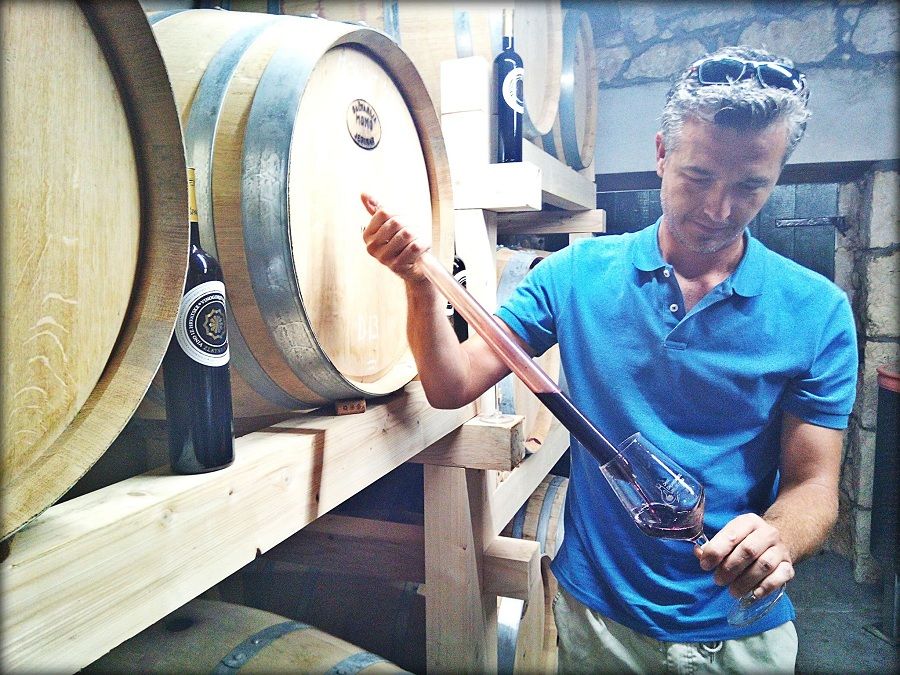
Once upon a time, the Vrgorac Field was a typical karst field, flooded in the winter, dry in the summer. During the Turkish rule, Vrgorac was an intersection of roads, a strategically important town. When the Venetian conquests began in the Dalmatian hinterland, they decided to flood the field to better defend from the Venetian invasion. There are major springs of water in the field, but large openings in the karst soil drained the water into the sea or Neretva river. The Turks, therefore, used the animal skin to close the openings. When the first major rain fell, the water could not run to the sea or Neretva and a lake was formed. It existed continuously for several hundred years, with some 150 islets. Only in 1938, as part of melioration works, channels were created which re-established the former water regime.
The lake is surrounded by Rilić, the southern end of the Biokovo massif. Dario loves Rilić, nature and hiking, and he regularly goes to fetch the water from the mountain springs some 600 metres above sea level. In the whole of Rilić, there are at least twenty springs of water. Rilić is ideal for picking snails as well, and the biggest concentration of snails can be found in April.
The Matica river which passes through the Vrgorac Field is fed by some twenty springs and this makes the region, unlike some others in Dalmatia, ideal for vegetable and fruit growing. This area is the southernmost part of Zagora, where it connects with the Neretva region.
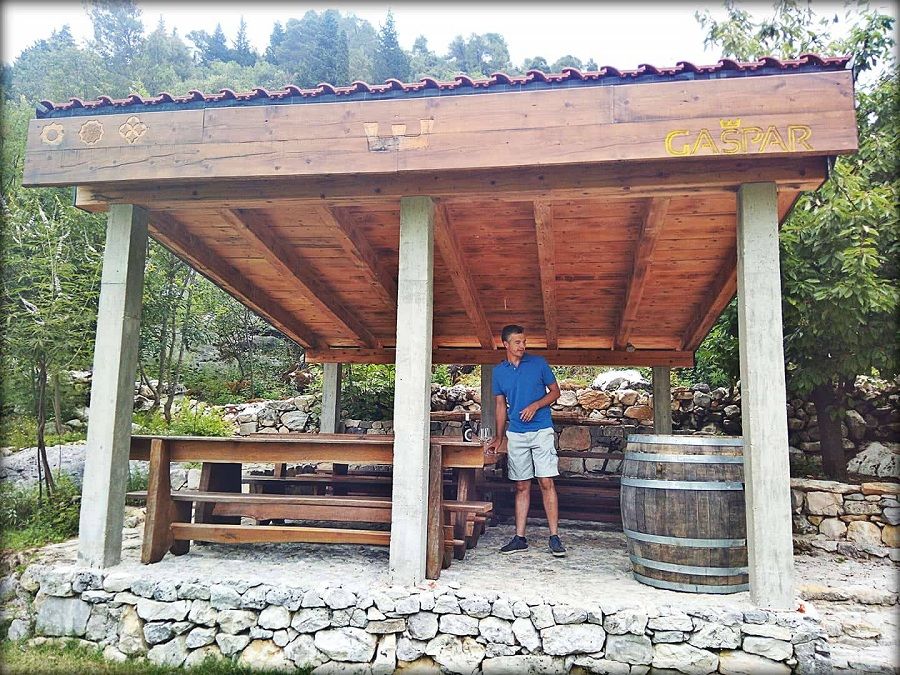
STEP BY STEP TOWARDS A SUCCESSFUL WINE STORY
“Every family living in this area had a vineyard, including mine. This is part of the tradition here. There is no household even today which does not produce wine for its own needs. In 1938, my granddad was selling wine in Vrgorac and the business was doing fine because there was no beer and people were massively drinking wine. But that lasted for a short time since only two and a half years later the war started, and after the war, private business entrepreneurship was not allowed, as you know.” Due to historical circumstances, an entrepreneurial story was stopped in its tracks and it took nearly seventy years for grandsons Dario and Boris to continue where the grandfather had stopped and to start to produce wine for the market, not just for personal needs.
Dario says the Vrgorac region was falling behind other wine-producing areas, but the Gašpar winery has overcome the lag and become the leader of a small movement which aims to make the Vrgorac wines attractive. From Zadar to Dubrovnik, the Jezero winegrowing area used to supply small wineries with grapes, which then sold the wine to tourists and passersby along the Adriatic highway. But Dario correctly concluded that the area should not only be a raw material base for other wineries but that it should create a brand of Vrgorac wines, wines from Jezero, i.e. top-quality wines.
"Until 2002, I did not even drink wines; they were in some ways repulsive to me because I was not in touch with top-quality wines. In 2002, my friends and I visited several wine exhibitions and were delighted with the offer, and subconsciously I took note of my own family’s winegrowing tradition, and I thought that I could bring the wines from my own vineyard up to that level. At the time we had some 12,000 vines and like other producers in this area we sold our wines to others, but I was convinced that we could achieve a lot more than that. That thought slowly matured within me and our first wine was produced in 2010 without any technology. Of course, I was not completely satisfied and then I said that we were either going to produce something good or we would not produce anything.”
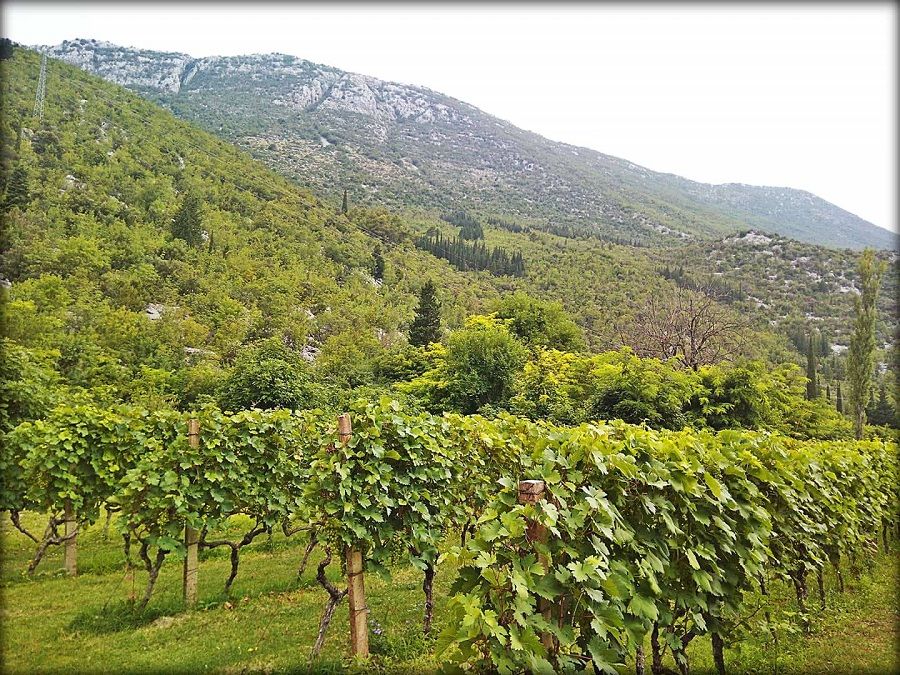
He first surrounded himself with good people who knew how to advise him and whose suggestions he was open to, and then he began to educate himself. He attended more than a dozen seminars each year and was extremely helped by mentor Davor Mitrović, who worked for seven years with Zlatan Plenković.
First it was necessary to return an almost extinct vine variety to vineyards, and then learn how to cultivate it in a high quality manner because he did not have anyone to look up to. Each variety is different, and quality standards needed to be achieved. Subsequently the issue of wine cellars came, how the wine should be taken care of. And, in the end, it is necessary to make the wine recognisable in the market, create a circle of enthusiasts and consumers. They started from scratch and successfully overcame all the challenges that came. They are not afraid of the competition, and they actually look forward to it. Healthy competition is indispensable not to slip into laziness and lethargy. If someone makes a positive breakthrough, that sets the standard which others have to follow. One year, one winery will make a step forward, the other one some other winery, and then everyone will progress. At the moment, there are five serious winemakers in the Vrgorac area, and Dario says he wants at least twenty-five of them! In addition to the Gašpar winery, there is also the Pilač winery from Vrgorac and three other wineries from Dubrovnik-Neretva County.
“At the same time the state created the counties, it also created new winegrowing areas. One part of this land belongs to Split-Dalmatia County and the Vrgorac wine area, while the other belongs to Dubrovnik-Neretva County and Neretva wine area, although it is a natural whole which is now artificially divided by administrative county boundaries.”
Since 2015, all their wines have been of superior quality, with the exception of Zlatarica which does not fulfil the dry extract concentration rule. But this does not mean that the wine is lagging behind other wines, but that is just the Croatian wine law. “Zlatarica is the first wine which is sold out, that is the wine which the market demands,” says Dario with a smile and adds, "My first wine that was assessed to be of superior quality was officially marked as table wine because I did not have technical conditions in my cellars to get the superior-quality wine certificate.”
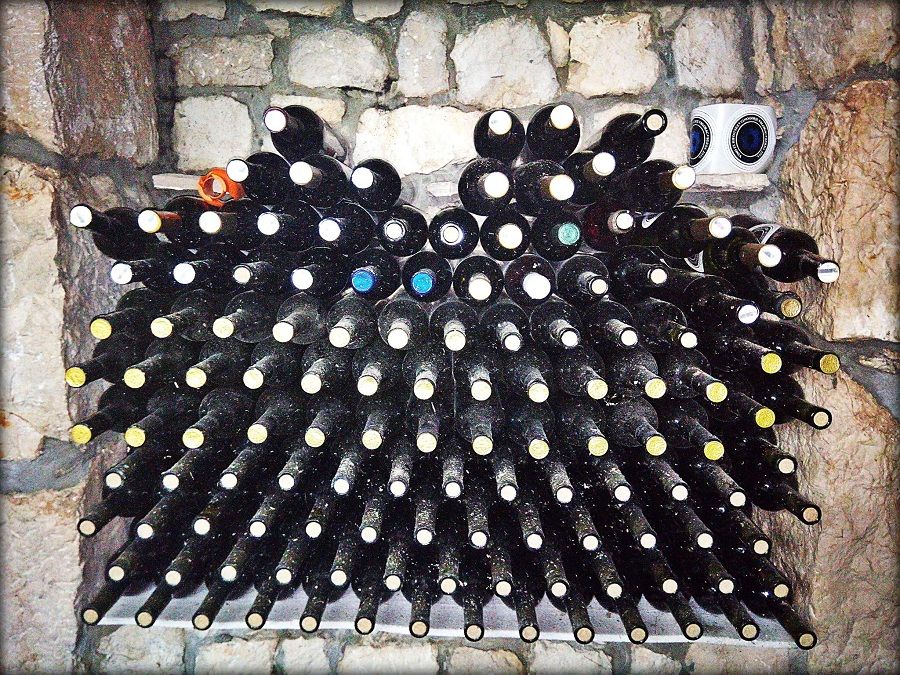
SHOCK IN ACADEMIC CIRCLES
They have 14,500 vines, but their annual production is relatively small, only 7,000 to 9,000 bottles, indicating that their focus is primarily on quality and not quantity. They did not have enough Zlatarica vines and this year they planted new ones. They signed an agreement with the Agriculture Faculty and the Town of Vrgorac as partners in a five-year study to monitor Zlatarica in their vineyards. The ultimate goal is the clonal selection and virus elimination. “I work out of love and intuition, and I am glad that the whole story will now include experts, that things will be standardized and raised to a higher level.”
Unlike Zlatarica, Plavka is not endangered; it is the seventh most cultivated variety in Croatia and the second most popular red variety in Dalmatia. Until now, it was not paid enough attention, and the brothers Dario and Boris decided to prove that Plavka was unjustifiably neglected and that superior-quality wines can be produced from it, a thought which was part of the realm of science fiction until very recently.
“Professor Edi Maletić and I both love each other and fight each other because it used to be hard for him to believe that I made superior-quality wine exclusively from Plavka. I am very proud of this because we are the only ones to have succeeded in this in the whole country, for three consecutive years. I think that Plavka I am going to produce from the 2017 grapes will be the best red wine I ever made,” says Dario without false and unnecessary modesty, while exuding optimism and positive energy.
“This success with Plavka has also given impetus to scientific research, because the academic community was shocked with the success, positively, of course. The point is that my Plavka spends three to four months in the water. That is not marsh water, but water from the mountains and when the water withdraws it washes away the lime. For the next eight months, the plants do not receive any water except some rain. They are located on a mild slope towards the river and there is no water retention which can favour various diseases. I also give it very little artificial fertilizers, I cut it short; it produces a lot of grapes, but I intentionally do not want high yields and vines are 30 to 40 years old. In addition, I have nine plots with Plavka, and on one plot I have good acids, on another excellent sugars, and in a synergy that all results in top-quality wines.”
Trnak is an indigenous grape variety in the Vrgorac, Imotski and Western Herzegovina areas, but it has almost disappeared. The Gašpar brothers are for now just cultivating this variety, and next year they will start producing wines. For now, wines from Trnak are produced just by Franić and Pilač wineries from Vrgorac, Grabovac and Đuzel from Imotski, and Nuić from Herzegovina. According to Dario, Trnak is the Croatian red variety which has the greatest potential, it is the future of red wines. If they managed to get the maximum out of Zlatarica, there is no doubt they will succeed with Trnak as well.
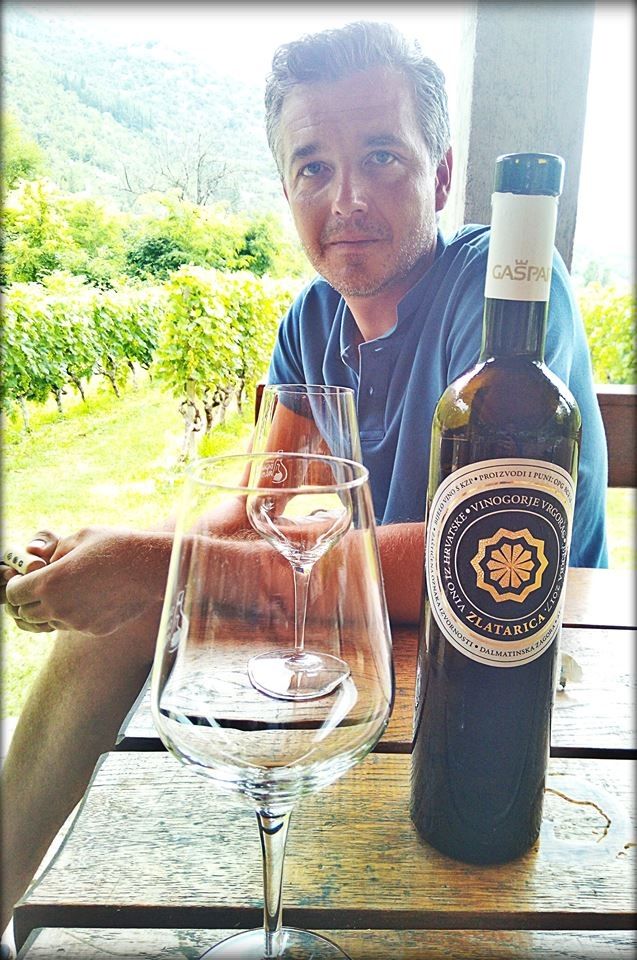
VALORISATION OF WINE AS TOURIST RESOURCE
This year, the wine-tourism idea was approached more seriously. “More and more tourists are discovering the inland Dalmatia. For the tourism to function, it is necessary to have the infrastructure, and fortunately, the majority of new accommodation facilities in the Dalmatian hinterland is of top quality. The coast is overcrowded in the peak season and tourists want to escape inland, but to have the coast and the beaches within reach in half an hour. For the tourism to function, we also need events which will attract tourists. Three years ago, we started the Days of Dalmatian Prosciutto and Wine in Vrgorac. The first year we had several hundred visitors, the second year 2,000 to 3,000, and this year 5,000 to 6,000 visitors.”
Dario says that the event has brought together all prosciutto producers from Istria to Konavle; they pair prosciutto with wines, and various workshops and presentations are held. The project also involves cross-border cooperation with Western Herzegovina, since it belongs to the same Dinaric cultural and civilization circle. The combination of wine and prosciutto is logical because Vrgorac is known for its Pivac Brothers meat industry. The Vrgorac prosciutto and Vrgorac wines are now standing shoulder to shoulder.
AMBASSADORS OF ZLATARICA AND PLAVKA
In addition to local events, Dario regularly participates in all major wine festivals in the region. He says that he often finds himself in an awkward situation when people want to order larger quantities of his wines, but he cannot deliver them due to small production quantities and the focus on top quality. When people ask him what he is doing there then, he simply responds: “I came to get you acquainted with our beautiful, autochthonous wines.” For three years, they have been producing the same quantities, but in line with market laws and the supply and demand ratio, the price has jumped significantly. This made the wine Dario’s primary source of income, so he can now devote himself to it 24 hours a day. “We do not want to increase the quantity to the detriment of quality. We will produce more wines only when new plots start to bear good grapes,” say Dario and Boris Gašpar resolutely.


